Capricornus is a faint zodiac constellation located in the southern sky. Its name means “the goat” in Latin. The constellation represents a sea goat, a mythical creature associated with the god Enki in Babylonian mythology and later with the Greek deity Pan. The constellation is represented by the symbol ♑.
Like other zodiac constellations, Capricornus was first catalogued by the Greek astronomer Claudius Ptolemy in his Almagest in the 2nd century CE. In Greek mythology, the constellation is associated with Pan, the god of the wild, and with the goat Amalthea, who suckled Zeus when he was very young.
Capricornus constellation is home to the eclipsing binary system Delta Capricorni (Deneb Algedi), the multiple star systems Beta Capricorni (Dabih) and Alpha Capricorni (Algedi), and the white giant Nashira (Gamma Capricorni). Notable deep sky objects in the constellation include the globular clusters Messier 30 and Palomar 12, and the compact galaxy group HCG 87.
Facts, location & map
Capricornus is the 40th biggest constellation in the sky, occupying an area of 414 square degrees. It lies in the fourth quadrant of the southern hemisphere (SQ4) and can be seen at latitudes between +60° and -90°. The neighboring constellations are Aquarius, Aquila, Microscopium, Piscis Austrinus, and Sagittarius. The best time of year to see Capricornus is during the month of September.
The constellation name Capricornus is pronounced /ˌkæprɪˈkɔːrnəs/. In English, the constellation is known as the Sea Goat. The genitive form of Capricornus, used in star names, is Capricorni (pronunciation: /ˌkæprɪˈkɔːrnaɪ/). The three-letter abbreviation, adopted by the International Astronomical Union (IAU) in 1922, is Cap.
Capricornus belongs to the zodiac family of constellations, along with Aries, Taurus, Gemini, Cancer, Leo, Virgo, Libra, Scorpius, Sagittarius, Aquarius, and Pisces.
Capricornus has five stars with known planets and contains one Messier object, the globular cluster M30 (NGC 7099). The constellation is home to three stars located within 10 parsecs (32.62 light years) of the Sun. The brightest star in Capricornus is Deneb Algedi, Delta Capricorni, with an apparent magnitude of 2.81. It is the only star in the constellation brighter than magnitude 3.00.
The constellation contains five named stars. The star names approved by the International Astronomical Union (IAU) are Algedi, Alshat, Dabih, Deneb Algedi, and Nashira.
There are five meteor showers associated with Capricornus: the Alpha Capricornids, the Chi Capricornids, the Sigma Capricornids, the Tau Capricornids, and the Capricorniden-Sagittarids.
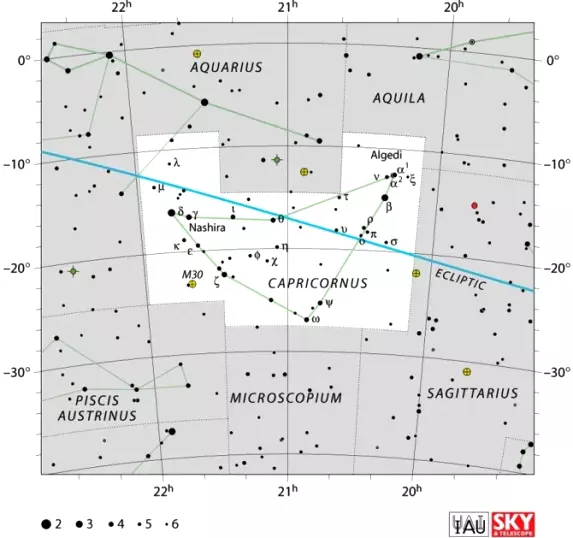
Capricornus constellation map by IAU and Sky&Telescope magazine
Where is Capricornus?
Capricornus can be found using the bright stars of the constellations Pegasus, Aquila, Sagittarius and Piscis Austrinus, but since it is very faint, it requires exceptionally good conditions to be seen. It lies in the region of the sky between Enif, the brightest star in Pegasus, Altair, the luminary of Aquila, Ascella, one of the bright stars of the Teapot in Sagittarius, and Fomalhaut, a solitary first-magnitude star in Piscis Austrinus, found near the imaginary line extended from Scheat through Markab across the sky.
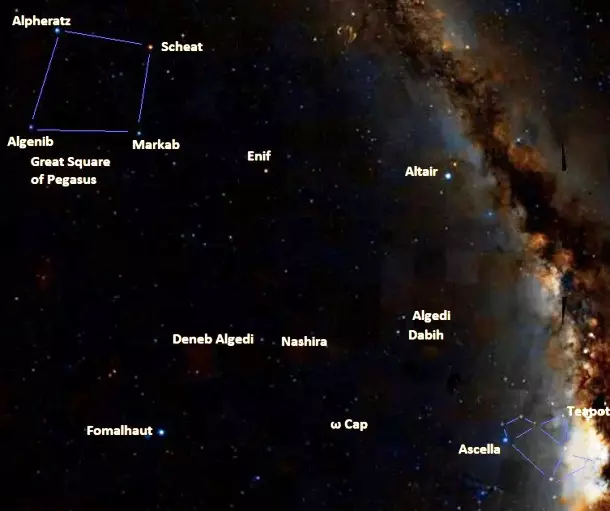
Capricornus location, image: Wikisky
The visible stars of the goat constellation form a pattern reminiscent of two horns, with the luminaries Deneb Algedi and Nashira marking one tip and Algedi and Dabih the other. The faint Omega Capricorni lies at the bottom of the triangular pattern, near the border with Microscopium and just north of the imaginary line connecting Fomalhaut and Ascella. Deneb Algedi is the only star in Capricornus brighter than magnitude 3.00, which means that the constellation is very difficult to see from light-polluted areas.
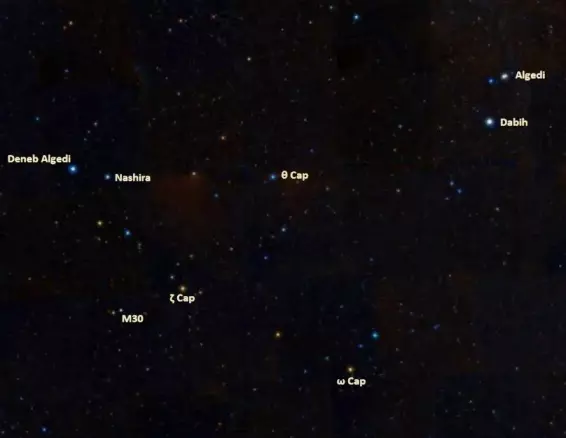
Capricornus stars, image: Wikisky
Capricornus myth
Even though Capricornus is one of the faintest constellations in the sky, it is associated with myths and images that date back to the 21st century BCE.
The story of Capricornus originated with the Babylonians and Sumerians. The Sumerians knew the constellation as the goat-fish, or SUHUR-MASH-HA, while Babylonian star catalogues compiled around 1000 BCE called it MUL.SUHUR.MAŠ, also meaning “goat fish.” In the early Bronze Age, Capricornus marked the winter solstice and, in modern astrology, Capricorn’s rule still begins on the first day of astronomical winter.
The Greeks associated the constellation with the forest deity Pan, who had the legs and horns of a goat. Crotus, his son, is usually associated with another amphibious creature, represented by the neighboring constellation Sagittarius.
Pan was placed in the sky by Zeus in gratitude for his coming to the other gods’ rescue on several occasions. During the gods’ war with the Titans, Pan helped scare the Titans away by blowing his conch shell. Later, he warned the gods that Typhon, a monster sent by Gaia to fight them, was approaching. He also suggested that gods disguise themselves as animals until the danger passed.
In the myth, Pan eluded the monster himself by jumping into the river Nile and turning the lower part of his body into that of a fish. Zeus eventually struck down Typhon with his thunderbolts. In reference to the myth, Capricornus is still often depicted as a goat with the tail of a fish.
In another story, Capricornus is identified as Amalthea, the goat that suckled Zeus when he was an infant, hiding from his father Cronos. Cronos had devoured his other children, all future gods and goddesses, because of a prophecy that said that he would be overthrown by one of them.
Major stars in Capricornus
Deneb Algedi – δ Capricorni (Delta Capricorni)
Delta Capricorni is the brightest point of light in Capricornus. It is a multiple star system with an apparent magnitude of 2.81, located at a distance of 38.70 light years from Earth. The primary component (Delta Capricorni Aa), formally named Deneb Algedi, is a giant star in an eclipsing binary system. The two components – δ Cap Aa and δ Cap Ab – orbit each other with a period of 1.022768 days. When the fainter star eclipses the giant, the system’s visual magnitude drops by 0.24. When the giant eclipses the companion, the brightness decreases by 0.09 magnitudes. The system is classified as an Algol-type variable.
Delta Capricorni A has two visual companions, both significantly fainter. A fifteenth magnitude companion lies about 1 arcminute away and a thirteenth magnitude star is separated by more than two arcminutes from the primary.
The name of the primary component, Deneb Algedi, is derived from the Arabic ðanab al-jady, meaning “the tail of the goat.” The star was also traditionally known as Scheddi.
Delta Capricorni A shows the spectrum of a white giant star of the spectral type A7m III. The primary component has a mass double that of the Sun and a radius of 1.91 solar radii. With a surface temperature of 7,301 K, it shines with 8.5 solar luminosities. The star is a fast spinner, with a projected rotational velocity of 105 km/s.
Delta Capricorni was found to be a metallic-line star in 1957. It is one of the brightest metallic A stars in the sky. For a time, it was believed to be a Delta Scuti variable, a pulsating star whose brightness varies as it expands and contracts. However, observations with the ROSAT satellite in the early 1990s did not find any evidence of short-period variation.
Deneb Algedi lies only 2.6 degrees south of the ecliptic and is occasionally occulted by the Moon and, more rarely, by planets.
Dabih – β Capricorni (Beta Capricorni)
Beta Capricorni is a multiple star system located 328 light years away. It is the second brightest point of light in Capricornus. The primary component, named Dabih, is the constellation’s second brightest individual star, with an apparent magnitude of 3.05. The name Dabih comes from the Arabic al-dhābiḥ, meaning “the butcher.”
The Beta Capricorni system is composed of five stars. In binoculars, the system appears as a binary star. The brighter component is designated Beta1 Capricorni (Beta Capricorni A) and the fainter, Beta2 Capricorni (Beta Capricorni B). The two components were traditionally known as Dabih Major (Beta1 Capricorni) and Dabih Minor (Beta2 Capricorni). The stars are separated by 3.5 arcminutes on the sky and the physical distance between them is at least 0.34 light years (21,000 astronomical units). They orbit each other with a period of 700,000 years.
Beta1 Capricorni is itself a multiple star system consisting of three stars: Dabih, which is a single star, and a binary pair. Beta2 Capricorni is also a binary star. It is considerably fainter than Beta1, with a visual magnitude of 6.09.
Dabih (Beta Capricorni Aa) is an orange bright giant of the spectral type K0II. It has a radius 35 times that of the Sun and, with an effective temperature of 4,900 K, it is 600 times more luminous than the Sun. The binary pair Beta Capricorni Ab1 and Ab2 has an orbital period of 8.7 days. The dominant star is a blue B-type main sequence dwarf. It is separated by only 5 astronomical units (0.05 arcseconds on the sky) from Dabih. The two stars complete an orbit every 3.77 years.
The components of Beta2 Capricorni are a white, class A0 giant and a mercury-manganese star. The giant is 40 times more luminous than the Sun. The companion lies at a separation of about 3 arcseconds.
Algedi – α2 Capricorni (Alpha2 Capricorni)
The Bayer designation Alpha Capricorni is used for two star systems: Alpha1 Capricorni and Alpha2 Capricorni. The two are not physically related. They appear 0.11 degrees apart on the sky and, like Mizar and Alcor in Ursa Major, they can be resolved by the unaided eye.
Alpha2 Capricorni is the brighter of the two. The system consists of three stars and shines at magnitude 3.57 from a distance of 102 light years. The primary component, formally named Algedi, is a yellow giant or subgiant star of the spectral type G8.5III-IV. It has a mass of 2.05 solar masses and, as it evolved away from the main sequence, it has expanded to a size of 8.38 solar radii. With a surface temperature of 5,030 K, it shines with 40.4 solar luminosities. The star is a slow spinner, with a projected rotational velocity of 2.7 km/s. Its estimated age is about 1.30 billion years.
The name Algedi (also spelled Algiedi) is derived from the Arabic al-jadii, meaning “the goat.” The name was traditionally used both for Alpha2 and Alpha1 Capricorni, but now formally applies only to the primary component of Alpha2. The star was also known as Secunda Giedi or Algiedi Secunda.
The other two components of the Alpha2 Capricorni system form a binary pair with an orbital period of about 244 years. The two stars orbit the primary with a period of about 1,500 years. Both stars are about half as massive as the Sun.
Alpha1 Capricorni, traditionally known as Prima Giedi or Algiedi Prima, is much more distant than Alpha2. It lies about 870 light years away. It is also fainter, shining at magnitude 4.27. The star is a yellow supergiant of the spectral type G3 Ib. It has a mass 5.3 times that of the Sun and is 1,047 times more luminous than our star.
Alpha1 Capricorni has three dim visual companions, but these are not believed to be physically related to the star.
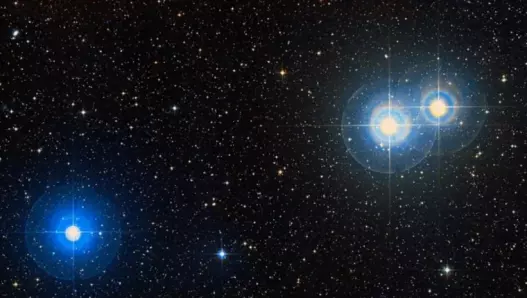
Algedi and Alshat (Alpha and Nu Capricorni), image: Wikisky
Alshat – ν Capricorni (Nu Capricorni)
Alshat is a double star that appears in the same field of view as Alpha Capricorni. It has an apparent magnitude of 4.76 and lies at a distance of 253 light years. The spectral type given is B9 IV or B9.5 V, indicating a hot blue star that is either still on the main sequence or has evolved into a subgiant. The name Alshat comes from the Arabic aš-šā[t], meaning “the sheep.”
The primary component has a mass 2.37 times that of the Sun. It is 87 times more luminous than the Sun, with a surface temperature of 10,461 K. The star’s estimated age is 115 million years. The companion is significantly fainter, with a visual magnitude of 11.8. It lies 54.1 arcseconds from the primary star. Based on the data from Gaia Data Release 2, the companion is much more distant from Earth than the primary component.
Nashira – γ Capricorni (Gamma Capricorni)
Nashira is a chemically peculiar Am star with the stellar classification kF0hF1VmF2. It has an apparent magnitude of 3.67 and lies at a distance of 139 light years. It is classified as an Alpha2 Canum Venaticorum variable, a chemically peculiar star with a strong magnetic field. The star’s brightness fluctuates by 0.03 magnitudes.
The name Nashira comes from the Arabic sa’d nashirah, meaning “the lucky one” or “bearer of good news.”
ζ Capricorni (Zeta Capricorni)
Zeta Capricorni is another binary star in Capricornus. It has a visual magnitude of 3.74 and lies at a distance of 386 light years from Earth.
The primary component is a yellow giant of the spectral type G8IIIp and the companion is a hydrogen-rich white dwarf with the stellar classification DA2.2. The stars orbit each other with a period of 2378.2 days.
Zeta Capricorni A has a mass 3.99 times that of the Sun and a radius about 29 times solar. With an effective temperature of 5,397 K, it shines with 490 solar luminosities. It is classified as a barium star and is notable for having an overabundance of praseodymium. The white dwarf has the same mass as the Sun and a surface temperature of 23,000 K.
Zeta Capricorni has traditionally been called Yan or Marakk, but neither name has been formally approved by the International Astronomical Union (IAU).
Dorsum – θ Capricorni (Theta Capricorni)
Theta Capricorni is a white main sequence star of the spectral type A1 V. It has an apparent magnitude of 4.07 and lies 162 light years away. The star has the traditional name Dorsum, meaning “back” (referring to the back of the goat), but the name has not been formally approved by the IAU.
Theta Capricorni has a mass of 2.24 solar masses and a radius 2.7 times that of the Sun. With a surface temperature of 10,001 K, it is 65 times more luminous than our star. The star is a fast rotator, with a projected rotational velocity of 104 km/s. Its estimated age is 152 million years.
Baten Algiedi – ω Capricorni (Omega Capricorni)
Omega Capricorni is an orange giant star with the stellar classification K4 III. It has an apparent magnitude of 4.11 and lies at an approximate distance of 1,000 light years. The star does not have a formal name, but it has traditionally been known as Baten Algiedi, meaning “the belly of the goat.”
Omega Capricorni has a mass 6.8 times that of the Sun and has expanded to a size of 172.1 solar radii as it evolved away from the main sequence. With a surface temperature of 3,915 K, it shines with 6,269 solar luminosities. The star is a fairly slow spinner, with a projected rotational velocity of 4.68 km/s. Its estimated age is 48.1 million years.
Like Zeta Capricorni, Omega is classified as a barium star. This indicates that it may have a white dwarf companion.
ψ Capricorni (Psi Capricorni)
Psi Capricorni is a yellow-white main sequence star of the spectral type F5 V. It has a visual magnitude of 4.13 and lies 47.9 light years away. The star has a mass of 1.37 solar masses and a radius 1.51 times that of the Sun. It shines with 3.82 solar luminosities. It shows an infrared excess, indicating the presence of a debris disk orbiting the star at a distance of 38.75 astronomical units.
Psi Capricorni came within 20 light years of the Sun about 467,000 years ago. Now it is moving away with a radial velocity of 20 km/s. The star’s estimated age is 1.4 billion years.
Deep sky objects in Capricornus
Messier 30 (NGC 7099)
Messier 30 is a globular cluster approximately 27,140 light years distant and about 93 light years across in size. The cluster is approaching us at the speed of 181.9 km/s. It was one of the first deep sky objects discovered by Charles Messier. Messier described it as a circular nebula without a star in 1764. The cluster has an overall spectral type F3. Its estimated age is 12.93 billion years.
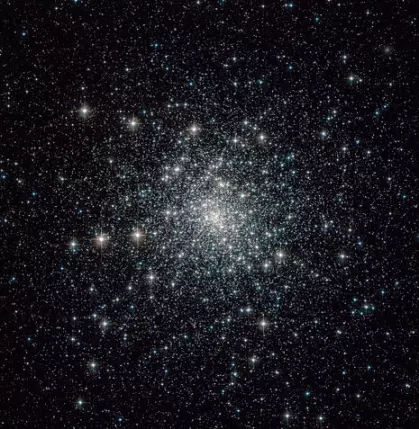
Messier 30 (NGC 7099) in Capricornus, image: Hubble Space Telescope (NASA, ESA)
M30 is relatively dense, with a concentration class V. The brightest stars in the cluster are magnitude 12 red giants.
Like Messier 15, Messier 70, and many other globular clusters in the Milky Way Galaxy, M30 has undergone a core collapse. Its core is now only 0.12 arc minutes in size, and half of the cluster’s mass is contained in a spherical radius that is 17.4 light years across.
M30 is easy to observe in small telescopes.
HCG 87
The Hickson Compact Group 87 (HCG 87) is a group of galaxies located about 400 million light years away. The largest member of the group, HCG 87a, is a spiral galaxy that appears almost exactly edge-on. Like its nearest neighbour, the elliptical galaxy HCG 87b, it has an active galactic nucleus with a black hole. The spiral galaxy HCG 87c (at the top of the image) is showing signs of active star formation. The interactions with its neighbours provide fuel for the starburst activity. The small spiral galaxy that appears in the centre of the group is believed to be a background object, unrelated to the group. The three members have apparent magnitudes of 15.3, 15.4 and 16.1.
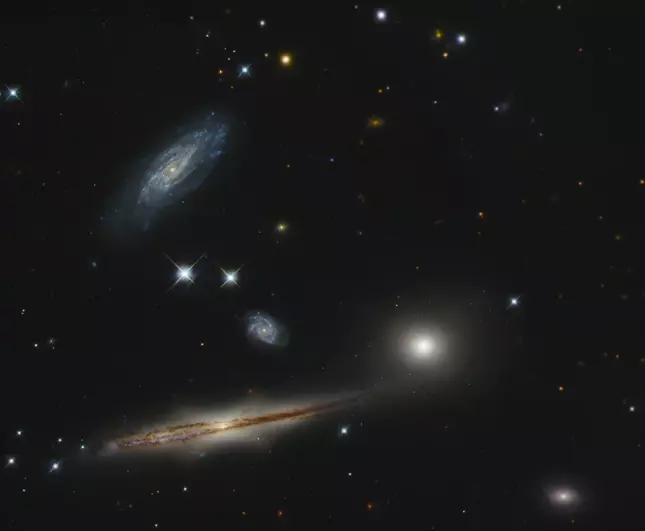
Hickson Compact Group 87, image: Judy Schmidt (CC BY 2.0)
IC 1337
IC 1337 is an intermediate spiral galaxy located about 420 million light years away. It has an apparent magnitude of 14.5 and an apparent size of 1.2’ by 1.1’. It was discovered by the French astronomer Stéphane Javelle on July 22, 1892.
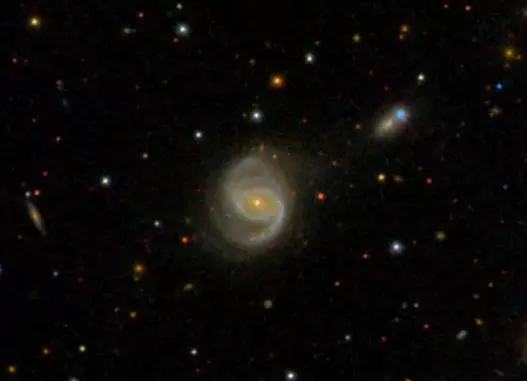
IC 1337, image: Sloan Digital Sky Survey
Palomar 12
Palomar 12 is a globular cluster located 63,600 light years away. It has an apparent magnitude of 11.99 and stretches across 17’.4 of the apparent sky, with a physical radius of about 162 light years. With an estimated age of 6.5 billion years, the cluster is about 30% younger than most globular clusters in the Milky Way. Once believed to have been captured from the Sagittarius Dwarf Elliptical Galaxy (SagDEG) by the Milky Way about 1.7 billion years ago, the cluster is now believed to still belong to the Milky Way satellite.
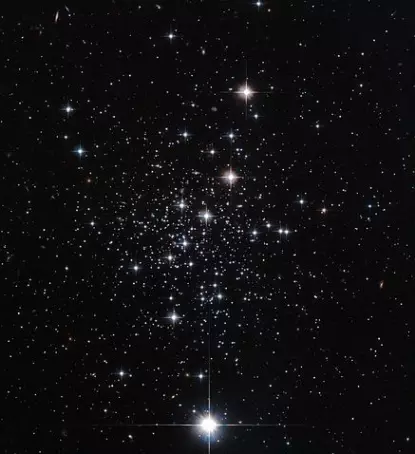
Palomar 12, image: ESA/Hubble and NASA